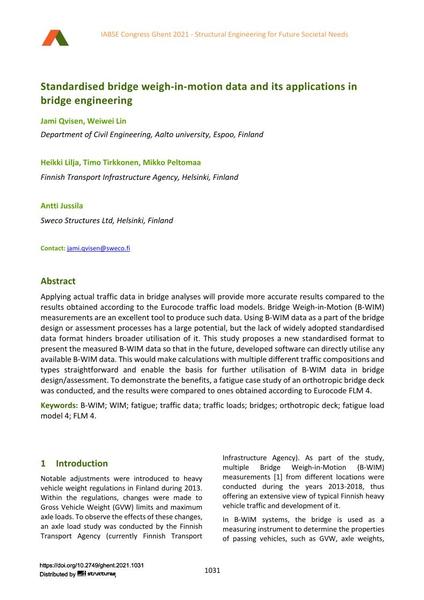Standardised bridge weigh-in-motion data and its applications in bridge engineering

|
|
|||||||||||
Bibliographic Details
| Author(s): |
Jami Qvisen
(Department of Civil Engineering, Aalto university, Espoo, Finland)
Weiwei Lin (Department of Civil Engineering, Aalto university, Espoo, Finland) Heikki Lilja (Finnish Transport Infrastructure Agency, Helsinki, Finland) Timo Tirkkonen (Finnish Transport Infrastructure Agency, Helsinki, Finland) Mikko Peltomaa (Finnish Transport Infrastructure Agency, Helsinki, Finland) Antti Jussila (Sweco Structures Ltd, Helsinki, Finland) |
||||
|---|---|---|---|---|---|
| Medium: | conference paper | ||||
| Language(s): | English | ||||
| Conference: | IABSE Congress: Structural Engineering for Future Societal Needs, Ghent, Belgium, 22-24 September 2021 | ||||
| Published in: | IABSE Congress Ghent 2021 | ||||
|
|||||
| Page(s): | 1031-1039 | ||||
| Total no. of pages: | 9 | ||||
| DOI: | 10.2749/ghent.2021.1031 | ||||
| Abstract: |
Applying actual traffic data in bridge analyses will provide more accurate results compared to the results obtained according to the Eurocode traffic load models. Bridge Weigh-in-Motion (B-WIM) measurements are an excellent tool to produce such data. Using B-WIM data as a part of the bridge design or assessment processes has a large potential, but the lack of widely adopted standardised data format hinders broader utilisation of it. This study proposes a new standardised format to present the measured B-WIM data so that in the future, developed software can directly utilise any available B-WIM data. This would make calculations with multiple different traffic compositions and types straightforward and enable the basis for further utilisation of B-WIM data in bridge design/assessment. To demonstrate the benefits, a fatigue case study of an orthotropic bridge deck was conducted, and the results were compared to ones obtained according to Eurocode FLM 4. |
||||
| Keywords: |
bridges fatigue orthotropic deck traffic loads B-WIM WIM traffic data fatigue load model 4 FLM 4
|
||||
| Copyright: | © 2021 International Association for Bridge and Structural Engineering (IABSE) | ||||
| License: | This creative work is copyrighted material and may not be used without explicit approval by the author and/or copyright owner. |
||||
